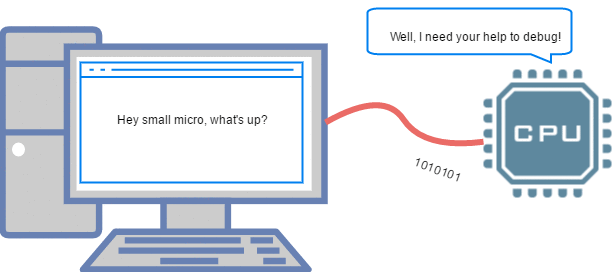Difference between revisions of "Serial Communication using Explore M3"
| (8 intermediate revisions by the same user not shown) | |||
| Line 1: | Line 1: | ||
[[Category:Explore M3 Bare Metal]] | [[Category:Explore M3 Bare Metal]] | ||
| − | In this tutorial we will see | + | In this tutorial we will see the serial communication on Explore M3 using ExploreEmbedded libraries.<br> |
| − | + | ||
| − | + | ||
[[File:0 UART main.gif]] | [[File:0 UART main.gif]] | ||
| + | <br><br> | ||
=Prerequisites= | =Prerequisites= | ||
| Line 15: | Line 14: | ||
=UART module= | =UART module= | ||
| − | Explore M3 has 4-UARTs (UART0-UART3) and | + | Explore M3 has 4-UARTs (UART0-UART3) and similarly the interfaces are suffixed with uart number.<br> |
Below table shows the Explore M3 UART pins.<br> | Below table shows the Explore M3 UART pins.<br> | ||
{| class="table table-striped table-hover table-condensed table-bordered" | {| class="table table-striped table-hover table-condensed table-bordered" | ||
|-class="info" | |-class="info" | ||
| − | ! | + | !UART Channel|| Explore M3 Pin || LPC1768 Pin |
|- | |- | ||
| − | | | + | |RX0 || 0 || P0.3 |
| − | |- | + | |- |
| − | | | + | |TX0 || 1 || P0.2 |
| − | |- | + | |- |
| − | | | + | |RX1 || 6 || P0.16 |
| − | |- | + | |- |
| − | | | + | |TX1 || 7 || P0.15 |
| − | + | |- | |
| − | |P0.10 | + | |RX2 || 4 || P0.11 |
| − | |- | + | |- |
| − | | | + | |TX2 || 5 || P0.10 |
| − | |- | + | |- |
| − | | | + | |RX3 || 2 || P0.1 |
| − | + | |- | |
| − | |P0. | + | |TX3 || 3 || P0.0 |
|} | |} | ||
| − | <br><br><br><br> | + | |
| + | <br><br><br> | ||
| + | |||
| + | =Code= | ||
| + | The below code shows uart communication on all the four UART channels with different baud rate.<br> | ||
| + | *Note:Refer the uart.h file for interface details. | ||
| + | |||
| + | <html> | ||
| + | <script src="https://gist.github.com/SaheblalBagwan/ad6df13a716a376f7a4828cbbe121e7b.js"></script> | ||
| + | </html> | ||
Latest revision as of 18:51, 28 April 2016
In this tutorial we will see the serial communication on Explore M3 using ExploreEmbedded libraries.

Prerequisites
Please check this tutorial for detailed explanation on Lpc1768 inbuilt UART module.
If you are doing it for the first time, then check the below links to setup the project for generating the .bin file.
UART module
Explore M3 has 4-UARTs (UART0-UART3) and similarly the interfaces are suffixed with uart number.
Below table shows the Explore M3 UART pins.
| UART Channel | Explore M3 Pin | LPC1768 Pin |
|---|---|---|
| RX0 | 0 | P0.3 |
| TX0 | 1 | P0.2 |
| RX1 | 6 | P0.16 |
| TX1 | 7 | P0.15 |
| RX2 | 4 | P0.11 |
| TX2 | 5 | P0.10 |
| RX3 | 2 | P0.1 |
| TX3 | 3 | P0.0 |
Code
The below code shows uart communication on all the four UART channels with different baud rate.
- Note:Refer the uart.h file for interface details.
